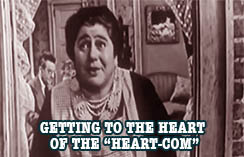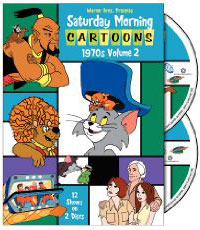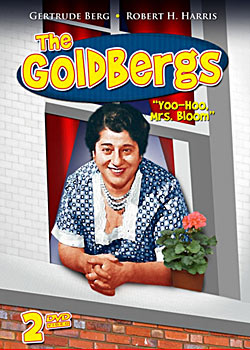


 |
 |
 |
||
|
It was a particular subset of the sitcom genre. It was a type of show that, within its 30-minute storytime, often stressed pathos as much as punchlines. It probably had its heyday in the 1960’s and early ‘70’s with the airing of such series as “Julia” and “The Courtship of Eddie’s Father.” But, in truth, it has often been with us and, in fact, it might never have left us either. Hence, it is also something that is sometimes difficult to define. It is the so-called “heart-com.” In fact, two of TV’s earliest hits probably fall squarely into the “heart-com” category but because both were 30 minutes in length and because we have lacked the vocabulary to label them something else, we have just called them “sitcoms.” These shows, specifically, were “Mama” and “The Goldbergs.” TV’s “Mama” (a derivative of “I Remember Mama,” first found in book form and then in film) is a lovely, charming program that aired (usually live) from 1949 to 1957. It followed the lives of “Mama” Hansen (played by Peggy Wood) and her New York-based, Swedish immigrant brood.
“Mama” could hardly be called a comedy. But it was hardly heavy-handed enough to be called a drama either. For example, the best known and most beloved episode of the series was titled “The Night the Animals Talked.” This instalment, a Yuletide fantasy focused on daughter Dagmar, was so well received when it first aired, it was restaged by the cast and rebroadcast by the network every Christmas. It’s a charming episode but not intended to be a laugh riot. Similarly, other episodes like “Mama’s Bad Day,” where Mama (Peggy Wood) is feeling unappreciated and an episode where son Nels learns he needs to wear glasses to correct his vision are enjoyable but certainly not meant to be gut-busting. In his legendary book, “The Great TV Sitcom Book,” Rick Metz assesses the plots of most “Mama” episodes as “warm and softhearted.”
“The Goldbergs,” of course, was Gertrude Berg’s radio carry-over series which told the story of a multi-generational Jewish family headed up by another wise matriarch, Molly Goldberg (played by Berg). Its stories were pleasant and sweet and, at times, comical but those expecting a “Lucy”-type or “Seinfeld”-eque half hour with this series are going to be left wanting. The program got most of its laughs thanks for Berg’s lead character Molly Goldberg’s frequent malapropisms. (Yelling about the telephone, “If it’s nobody, I’ll call back later!”) But beyond those chuckles, “The Goldbergs” were not big on out-and-out yucks.
Other shows of this era and of this ilk would have to include “Studs’ Place” (1949-1952) and “The Halls of Ivy” (1954-1955). Sill, make no mistake, many other shows of the era existed strictly to make you all-out guffaw: “I Love Lucy,” Burns and Allen, “My Little Margie,” and “Our Miss Brooks,” among others. And there other heart-com adjacent programming that also existed during this era would be the various domestic family sitcoms like Ozzie and Harriet and, a little later on, “Make Room for Daddy” and “Leave It to Beaver.” Those show, while they loved to make you laugh, also loved to convey a lesson or two to its audience usually via its younger cast members. That tradition would be long followed by many other family sitcoms—up through “The Brady Bunch” and through shows like “Full House” and “Family Matters,” etc. And, of course, many comedy shows over the years have gone full bore on the lessons part, giving birth to the often dreaded “very special episodes” that have befallen so many sitcoms. But, beyond that, dramas were dramas (you don’t laugh at “Dragnet”) and comedies were comedies (I am not looking for life advice from the castaways of “Gilligan’s Island”).
It was, mainly, in the latter 1960s, that the “heart-com” arrived full force. It was the aforementioned “Julia” (1968-1971) and “Courtship of Eddie’s Father” (1969-1972) as well as “Mrs. G. Goes to College” (Gertrude Berg’s post-“Goldbergs” show) (1961-1962); “Nanny and the Professor” (1970-1971); “A Touch of Grace” (Shirley Booth’s post-“Hazel” sitcom) (1973), and “Room 222” (1969-1972).
What beget its birth? Quite possibly, the hard-hitting nature of so many TV westerns and cop and medical dramas then on the air created a hunger for a kinder, gentler type of programming, one devoid of even slapstick or the shouting matches of even the funniest of TV couples. Along those same lines, the hard-hitting nature of so much of the real-life evening news coming into our living rooms during that time might have also made us yearn for something more wholesome, homespun and deeply reassuring. But this sort of all-in emotion (some might have called it cloying) didn’t really stick around. After all, in terms of TV comedy, the next decade, would be the world of Garry Marshall’s funny, feel-good nostalgia and Norman Lear’s full-on loud, comedy-led very hot topics. In the 1980s, however, the heart-com kind of returned. Only, this time, we called it the “dramedy.” These programs, however, never really caught on. Though “The Days and Nights of Molly Dodd,” with Blair Brown, was around for a while, its longevity was only aided by it finally moving and finding a more suitable home on the Lifetime channel. Meanwhile, shows like “Hooperman” (with John Ritter) and “The Slap Maxwell Story” (with Dabney Coleman) though, each around for a bit, were never anyone’s “appointment television.”
Today, I’m not sure that the heart-com in its classic “Courtship/Julia” form exists anywhere anymore but, today, more than ever, genres are even harder to define. “Law & Order” (all versions) is full-on drama but “Elsbeth” has some great humor to it. And cable’s “The Bear” just confuses everyone. But, then again, such mix and match, fluid formulas can make the medium a much more interesting place. |
|
